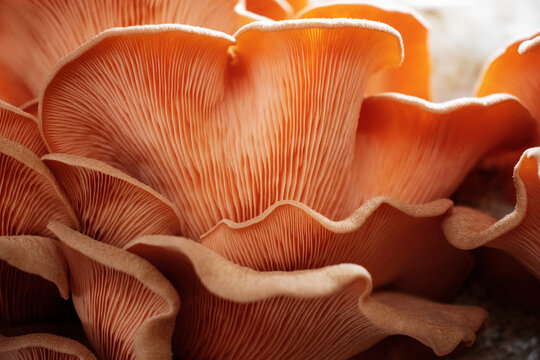Orange mushrooms can add a pop of color to your yard, but they often signify underlying fungal issues that could harm your plants or be toxic to pets and humans. Understanding how to identify these mushrooms, effectively remove them, and prevent future growth is crucial for maintaining a healthy and beautiful lawn.
Identifying Orange Mushrooms
Orange mushrooms typically belong to species like Jack-o’-lantern Omphalotus olearius or the smaller but equally vibrant Orange Mycena and also called Mycena leaiana. These fungi thrive in damp, shaded areas, often around decaying organic matter such as wood chips, tree stumps, or fallen leaves. They can range from bright orange to yellowish hues and often have a distinctive, sometimes unpleasant odor. Correct identification is essential before taking any removal actions, as some orange mushrooms are toxic. While orange mushrooms may seem harmless, they can pose various risks. Some species, like the Jack-o’-lantern mushroom, are highly toxic if ingested, causing severe gastrointestinal distress. Additionally, these fungi can indicate decaying wood or roots in your yard, potentially affecting the health of nearby plants and trees. In rare cases, the presence of certain mushrooms might also signify underlying soil health issues that could lead to more extensive problems if not addressed promptly.
Steps to Eradicate Orange Mushrooms
- Physical Removal
The first step in eradicating orange mushrooms is physical removal. Wear gloves to protect your skin, as some fungi can cause irritation. Carefully dig out the mushrooms, including the root-like mycelium, to prevent regrowth. Dispose of them in a sealed plastic bag to avoid spreading spores.
- Improve Yard Drainage
Mushrooms thrive in moist environments, so improving yard drainage is crucial. Aerate your soil to enhance water absorption and reduce waterlogging. Ensure that water runoff is directed away from your yard by grading the landscape appropriately. Adding organic mulch can also help retain moisture without creating overly damp conditions favorable to fungi.
- Remove Decaying Organic Matter
Since mushrooms often grow on decaying organic matter, regularly clean up fallen leaves, branches, and other debris. If you have old tree stumps or roots in your yard, consider removing them or using a stump grinder to eliminate potential fungal breeding grounds.

- Adjust Watering Practices
Overwatering your lawn can create ideal conditions for mushroom growth. Water your lawn early in the morning to allow the grass to dry throughout the day. Avoid excessive watering, especially in shaded areas, to keep moisture levels balanced.
- Apply Fungicides
In severe cases where mushrooms persist despite other efforts, consider using a fungicide. Choose a fungicide labeled for mushroom control and follow the manufacturer’s instructions carefully. While fungicides can be effective, they should be used sparingly to avoid potential harm to beneficial organisms in your soil.
Preventing Future Fungal Growth
Preventing future fungal growth involves maintaining a healthy yard environment. Regularly mow your lawn to the appropriate height, as taller grass can retain more moisture. Ensure your yard receives adequate sunlight by trimming overhanging branches and thinning dense foliage. Additionally, soil testing can help you monitor and adjust the pH levels and nutrient balance, promoting overall lawn health and reducing fungal susceptibility.
Removing orange mushrooms from your yard and preventing their return involves a combination of proper identification, diligent maintenance, and strategic interventions. By addressing the underlying causes of mushroom growth and creating an environment less conducive to fungi, you can enjoy a healthier, fungus-free yard. Remember, while mushrooms can be fascinating, they are best appreciated in their natural woodland habitats rather than your carefully cultivated garden.
